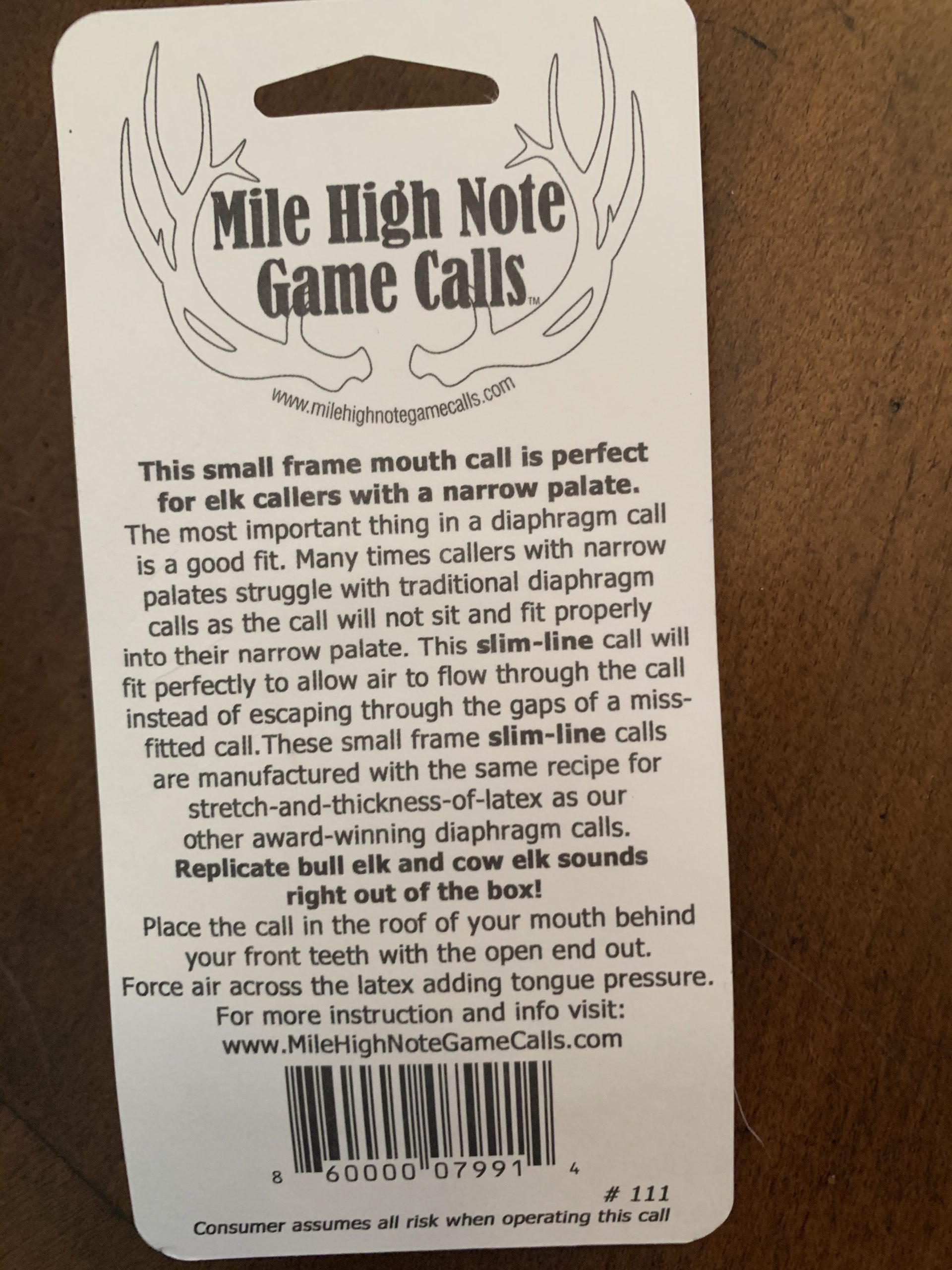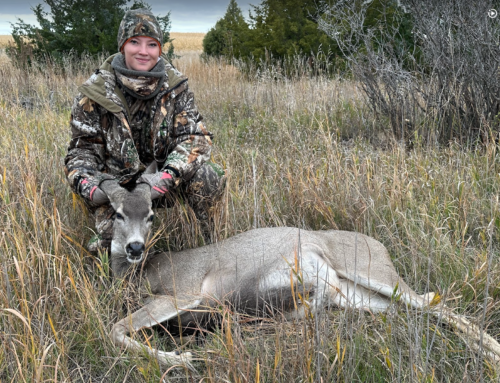Lauren picked up some turkey and elk calls at the Colorado Sportsman’s Show from these guys who hand make the calls in Colorado. Now, we just have to practice a bit more them them. Here is what turkeys sound like in the wild.
https://www.milehighnotegamecalls.com/
And, our daughter needs to find the turkey roost by the road next time we hunt our friend’s property, so that we know where they go before they roost. This article may help which was recently posted over at Project Upland by AJ DeRosa.
| New post on Project Upland … Every night as the sun sets turkeys will go to roost. Those locations can reveal patterns and provide indications about where we should be hunting no matter what our method or tactics. Why Do Turkeys Sleep in Trees? Turkeys sleep in trees for one basic reason: safety (which comes from evolution). Trees provide the protection they need to avoid being eaten by predators in the darkness as well as offering safety from weather. Unlike other quarry we hunt (e.g., whitetail deer), turkeys never move during the night unless absolutely necessary. This is not unique to turkeys; other game birds like the ruffed grouse also roost in trees during most of the year. Turkeys predictably fly up in a tree at dusk and come down in the morning to begin their day. This fact is a building block for successfully scouting and hunting turkeys. Where do you Find Turkey Roosts? Roosting trees are often located immediately next to an area where they can fly down with a clear landing. This can be as predictable as a farm field or as surprising as a large parking lot. Although this does account for the vast majority of roosting, there are areas of the country where turkeys roost inside a forest without a field to land in. Log landings and mature timber stands are primary locations for big woods turkeys. During certain times of the year, due to weather or coverage of leaves, turkeys can alter their roosting habits to shelter from winds or find more cover. This makes conifer stands particularly important in early seasons as the lack of leaves in general may not offer the cover a turkey wants like a conifer would. But user beware, as early scouting well before opening day can certainly result in changing roosts as the season comes closer. Wind can play a critical role as the lay of the land and age of the timber stand may contribute to how much wind shelter is provided. The concept of “reading the land” may not be necessary though, as the basic act of “roosting turkeys” and the anxiety of the shock gobble take a lot of guess work out finding roosts. Roosting trees tend to have good-sized branches that lay parallel to the ground. There can be as few as one turkey or even dozens in a single tree. In the spring as males begin their search for breeding hens they can often change roosts many times and break from the larger flock. This change becomes more dramatic as more hens are bred, resulting in toms searching greater distances for new breeding partners. How to Locate a Turkey Roost Turkey roosts can be identified in a number of ways. The most common and easiest is calling turkeys the night before or very early on the morning of the hunt. The other method is to watch turkeys from a distance in late afternoon to see where they go. Locating a Turkey Roost with Calls There are a number of ways to locate a turkey roost with calls and this method is primarily associated with what’s called a “shock gobble.” The shock gobble is a vocal response to the natural anxiety of toms that spurs them to gobble at the sound of predators and other loud noises. The most common calls used for this are owl calls, crow calls, and coyote calls. Other more sneaky and adapted methods include slamming a car door and beeping a horn (yes, I grew up in the suburbs of Boston after all). The best places to call are often areas that overlook vast areas of land so that sound can travel, or in open areas where roosting makes a lot of sense to the bird. The goal is to be loud and get that noise to travel. Immediately after calling we rely on silence to hear a response. The reaction is almost immediate and sometimes we have to relocate multiple times to get responses. Most people will drive and call from roads to cover large areas but make sure your engine is off to hear any response. Once a roost is located, which means it’s late enough for them to be in a tree, they will be in that tree until sunrise. We will take a look at what a morning looks like at a turkey roost a little later. It’s important to note that some people want to use an actual turkey call to locate turkey roosts. There is a lot of debate that surrounds this method as some believe offering up a turkey call creates call-shy birds. The theory is based on birds hearing a call early morning during preseason and following up said call with no reward. That basis may make the debate less relevant during the open season when calling to a bird on roost in the early morning (hence locating it) will result in them coming to your call. Which after all is a major point to hunting turkeys. The best calls for this method are turkey box calls as they are louder and travel a greater distance at a higher pitch. Although some people rely on using a box call to bring a turkey within shooting range, many people view the box call as a method to locate turkeys at distances while out hunting. Once located they switch to mouth calls and pot calls to bring the bird into shooting range. Another call that travels great distance? Beeping your car horn. Trust me on that one. Spotting Turkeys to Find Roosts Depending on where one lives it may be possible to spot turkeys at great distances using the lay of the land. Higher elevations that overlook vast areas allow a turkey hunter to use spotting scopes and binoculars to watch turkeys from a safe distance and see where they go to roost. This method is very straightforward but does eliminate areas you cannot get a visual on. Many hunters often combine their calling method with spotting turkeys. The biggest advice being saving the calling part for once we are confident birds are in a tree, as we do not want to start calling a bird to us (if you are using a turkey call) thus effectively deterring them from their natural roost. Physical Signs of a Turkey Roost Another way to locate turkey roosts is finding sign, which can be difficult. In areas where turkeys roost you will see lots of bird droppings under trees large enough to support turkeys. Turkey droppings are larger than other birds and the area will also have remnants of turkey feathers. Often turkeys can roost for generations in the same trees. A lot of this has to do with finding a location ideal to all their needs (that we might never quite understand). Making that generational tree a natural go-to spot as long as the area does not have any kind of major disturbance. These locations can be hard to miss if you’re paying attention to the evidence when you come across it. However, actually coming across one, unless you are going off of other evidence like birds gobbling from a roost, can depend on large helpings of chance. Nevertheless with enough boots on the ground while hunting, it’s not unlikely to stumble upon one. Daybreak at a Turkey Roost Turkeys are very vocal birds at first sign of light. Their morning will begin with a series of loud gobbles as they begin to wake up. This can last for some time until eventually they fly down and begin their day’s work on the ground. For this reason there tends to be a lot of human/turkey conflict in developed areas where residents are awakened every morning by the chatter of a turkey roost. The suburban hunter in me likes to point out that the nature of that human conflict can result in valuable intel. Local people talking about this (whether on social media or in a coffee shop) can be a great indicator on where to find a good turkey hunting location. Some will say that a turkey roost is located near all a turkey’s needs like water, strutting zones, and ample food. Which makes perfect sense. Because of those key factors turkeys will often return to the same tree night after night. Why Roosting Turkeys Matters Once you have located a turkey roost you have done the crucial lead work. Setting up around turkey roosts in the early hours can prove to be a deadly tactic that is one of the foundation stones of traditional turkey hunting. Legions of hunters will set up on field edges with turkey blinds and decoys after sneaking in and setting up near a turkey roost in hopes of stealing the heart of a lovesick tom to their location. But it’s important to note that getting too close to a turkey roost can result in birds flying out far distances and running away from the area altogether. It also can deter them from returning to a roost that evening. How close is too close to turkey roost is something that could certainly result in a lot of debating. When in doubt, stay far away as the risk is not worth the end result. Knowing the birds are in the area is a bigger advantage in and of itself. For some of us the method of setting up directly near a roost for an immediate fly-down hunt may not be how we hunt, but it does not dismiss the importance of a turkey roost. This starting point (and often daily ending point) results in travel routes, feeding areas, strutting zones, and locations that web out for a starting point for any style of turkey hunting. After all, it is where they live. … |



